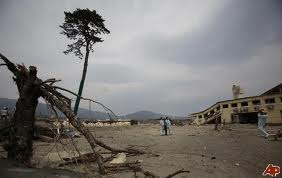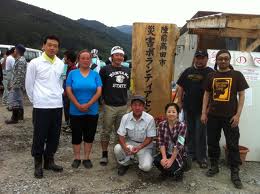Sunday, March 11 marks the first anniversary of the 9.0 earthquake and tsunami that killed over 20,000 residents of Japan’s Tohoku coast last year. Small cities and towns that few outside of Japan had ever heard of were suddenly world news. Tsunami waves, which at some points may have been 50 feet high, swept six miles inland with deadly force.
Immediately after the tsunami, many volunteers, the Japanese Self Defense Forces and US military troops traveled to Tohoku to bring food and medical care to the survivors, clear debris and begin rebuilding. This world of tragedy, confusion, and human compassion is the background of my next Rei book. This summer, I’ll go to Tohoku to continue my research and participate in the ongoing volunteer work. At this stage of the writing, however, I’m still locked at my desk in Minneapolis and have been gathering details about the disaster and its aftermath from Japanese volunteers who continue working hard on restoring damaged communities.

Dr. Jun Sato, a young economist at Gifu Shotoku Gakuen University, has been a great help to me, but more importantly, to the tsunami survivors. At his own cost, he travels six hours one way from his home in central Japan to Rikuzentaketa, a city in Iwate Prefecture that was completely destroyed by the tsunami. Ten percent of its people were killed or disappeared during the tsunami, and almost every building was destroyed. Out of a grove of thousands of old pine trees, only one survived; and its image has become the city’s emblem. Here are some questions Jun recently answered for me about volunteer work and Rikuzentaketa’s future.
Q: The photos of Rikuzentaketa are more devastating than the others I’ve seen. How is the city doing today?
Jun: Unlike other disaster areas, all of the downtown of Rikuzentaketa was destroyed and nothing other than debris is there. Many people have lost their friends, families and jobs. But they work hard and try to recover the city, and many people are helping them. What I can do is very small, but better than nothing. A lot of debris is everywhere, and we need to remove it. But it seems to me that more work is needed for mental care and employment. So letting many people know what is happening there is very important.
Q: What did you recently accomplish over a weekend’s work, and what are your plans for March 11?

Jun: Last weekend, I wiped off sand from postcards found in the debris. Most of them were greeting cards for the new year. The purpose is to return the to the owners and make an address book by reading the address and putting it into a PC. It was a mentally difficult task. You cannot wipe sand from a card without seeing a message on it. They wished a happy new year only two months before. But many people have participated in this painstaking task and that makes me encouraged.
I planned to be in Rikuzentaketa on March 11. But recently I decided not to go, because there will be a memorial service there, and residents want to do it peacefully with their families. In fact, the volunteer center is closed on March 11, considering the feelings of the residents.
Q: What was life like for survivors in the shelters?
Jun: I asked a member of my team. He visited a school gym in Kesennuma of Miyagi Prefecture a week after the quake and brought some foods and blankets. In the shelter, members of the Red Cross and Self Defense Forces were delivering food. Even at a big shelter, they did not have hot meals until three weeks after the quake. It took more than a month for people who were in small shelters or stayed in their own homes to have hot meals. After knowing it, my friend visited people who stayed in their homes and gave some food.
Q: Are Rikuzentaketa’s citizens still mostly in individual shelters (metal trailers)? Why aren’t they in real homes?
Jun: Yes, most of Rikuzentaketa citizens still live in temporary housing, which are located in uplands. The condition is not so good. For example, it is cold and noisy inside because the walls are thin. The shopping area and hospital are far from there. There are many obstacles to having their homes rebuilt. There seems to be some conflicts among citizens and the city, prefectural and central governments. The government basically wants residents to live in the uplands, but they know it is costly. Some residents want to stay where they used to live, but some want to move.
Another obstacle to rebuilding the disaster area is very few other areas of Japan accept debris for fear of radiation from the debris, even though no radiation is detected. it is unfortunate that many people regard debris as garbage. Once you do volunteer work, you immediately know that debris is not garbage. It is a piece of the daily life of the residents shattered by the tsunami. I want the people refusing to accept debris to think about how they feel when they have to give up something they got from their loved ones simply because it is broken and treated like gabage.
Q: Is “kizuna” the right word to express the strength of the volunteer-survivor connection?
Jun: A good question. Kizuna has several meanings. A dictionary says: i. anchoring animals to a tree; ii. affection among family members; iii. close ties established after some events among those who did not know each other well.
Kizuna was “word of the year” in 2011. Unfortunately, it seems to me many people use the word’s second meaning. People say that they try to see their parents and friends more often after March 11. But if using the third meaning, kizuna is right.
Since I started volunteer work, I feel a sense of unity with members who gather to help people–and even with their predecessors. In 1667, the residents in Rikuzentaketa started to plant trees to prevent salt damage. They could not see the grown pine trees. But what motivated them might be the smiling faces of people in the future. When I knew this fact, I noticed that what we are doing now is exactly the same as what the predecessors did. The pine trees that they dreamed of are just like those that we are dreaming of today. It encourages me a lot. The accomplishment by the predecessors quietly but clearly shows that someday we surely will look up at beautiful pine trees if we hope and continue our efforts. Now I feel close ties with members working with me and the predecessors more than 300 years ago. I would like to use the word kizuna to express my feeling.
